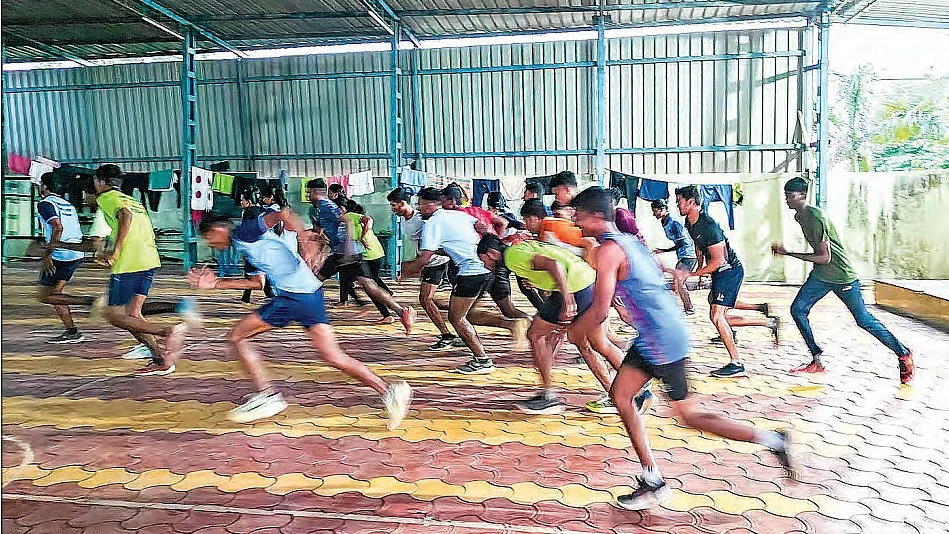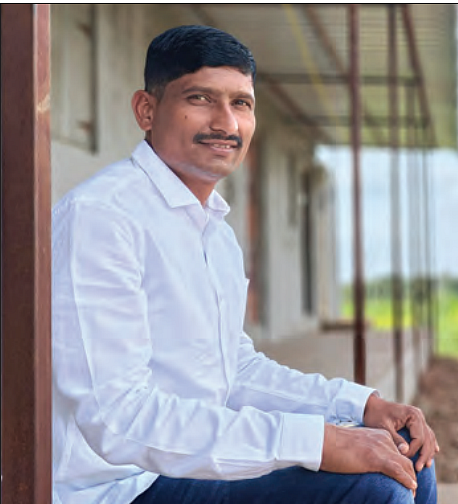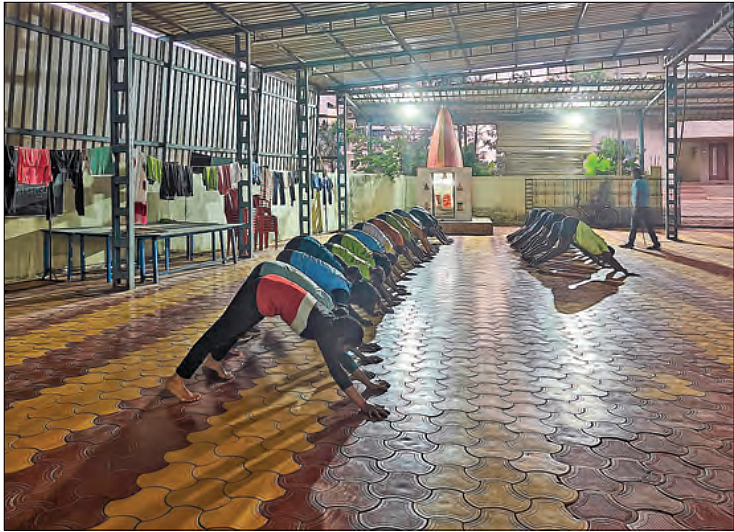‘In just four years, it’s all snatched away. It is so unfair’
The future looks bleak for young men and women across Maharashtra training desperately to become soldiers

Sooraj Jatti was not yet a teenager when he told his father he wanted to join the Indian army. His father, Shankar, a retired serviceman himself, beamed with pride at the thought of having inspired his son. “For me, it was an obvious choice because of the atmosphere in my house,” 19-year-old Sooraj says, in between his training sessions at an academy in Palus, a city in Maharashtra’s Sangli district. “As long as I can remember, I never thought about anything else.”
Less than a decade later, Shankar is no longer that proud father who delighted in his son’s decision. Somewhere along the line, he turned sceptical. To be precise, on 14 June 2022. That was the day Defence Minister Rajnath Singh held a press conference announcing the Agnipath scheme, under which “Indian youngsters will be provided an opportunity to serve in armed forces as Agniveer.” Before the introduction of the scheme, recruitment into the armed forces between 2015–2020 stood at 61,000. When the pandemic struck in 2020, recruitment was stopped.
The Agnipath scheme aimed to recruit around 46,000 youth into the Indian army. According to the government press release, the eligible age was set at 17.5–21 years, potentially bringing down the average age of the forces by 4–5 years. Unlike a lifelong army career, this is a four-year engagement, at the end of which 25 per cent of the batch would get a job in the regular cadre of the armed forces.
Shivaji Suryavanshi, 65, an ex-army man and president of Sainik Federation in the city of Kundal, also in Sangli, believes the scheme is against national interest. “Four years is too short a time for a soldier to be ready,” he says.
“If they are deployed in Kashmir or any other conflict region, their lack of experience can put other trained soldiers in danger. The scheme jeopardises national security.”
It is also disrespectful to those being enrolled. “If Agniveers die on duty, they don’t even get the status of a martyr,” Suryavanshi says. “It is shameful. If an MLA or an MP is in office for a month, he gets the same benefits as those legislators who serve their full tenure. Why discriminate against soldiers?” The controversial scheme was met with widespread protests across India after being announced, opposed by candidates and ex-servicemen alike.
After an underwhelming performance in the general elections of 2024, the BJP-led union government is reportedly considering amendments to it. The Bharatiya Janata Party suffered serious losses in states like Haryana, Punjab, Uttar Pradesh and Rajasthan, which are known for high recruitment in the armed forces.
Two years on, the disenchantment with the scheme is as evident as ever in western Maharashtra—a region also known for its high recruitment numbers. There are entire villages here that have sent at least one individual to the army from each household. Jatti belongs to one such household.
He is the final year of his Bachelor of Arts degree. However, ever since he enrolled in the academy to train, he spends six hours daily doing intense workouts. “It’s exhausting and doesn’t leave me any energy to concentrate on my studies,” he says, adding, “I will have to leave before the exams if I get selected.”
If he is selected as an Agniveer after a year of this rigorous training, Jatti should get Rs 21,000 a month in hand, going up to Rs 28,000 in the fourth year.

If he fails to be one among the 25 per cent recruited from his batch, he will come home with Rs 11.71 lakh at the end of his engagement. By then he will be 23, in the job market with no graduation degree to improve his chances. “That’s why my father is worried,” Jatti says. “He is asking me to become a police officer instead.”
The Indian government said that 46,000 Agniveers would be recruited in the inaugural year of 2022, of which 75 per cent—i.e., 34,500 youngsters in their early to mid-twenties—would go back home in 2026 with no prospects. All of them would have to start again, from scratch.
The upper limit for recruitment until 2026 is 175,000. The target is to increase the recruits to 90,000 in the fifth year and to 125,000 thereafter. Most of the men in uniform are children of farmers struggling with the agrarian crisis. Thousands of farmers have taken their lives due to rising debt, falling crop prices, lack of credit and the devastating impact of climate change.
For children belonging to farm households to land a job with a stable income over a sustained period is literally a matter of life and death. Prakash Bhore, who runs Yash Academy in Palus, believes the Agnipath scheme will worsen the employment crisis in rural India because it is designed in such a way that the youth often have to leave for duty before they can complete their graduation.
“The job market is already not promising,” he says. “Not having a degree would make it worse for the kids. Upon returning home after the four-year engagement, they would either work as security guards outside a society or an ATM.” Nobody would want to marry them either, he added.

“The bride’s family clearly asks if the prospective husband has a permanent job or is a ‘four-year army man’. Imagine a pool of frustrated youngsters trained to use firearms and nothing to do. I don’t want to say more but it is a scary picture.”
Major Himmat Owhal, who spent 17 years in the army, and has been running a training academy since 2009 in Sangli, says that the scheme has actually discouraged youngsters to join the army. “We used to have 1,500–2,000 kids enrolled in our academy every year since 2009,” he says. “Post Agniveer, that number has gone down to 100. It is a drastic drop.”
Under such circumstances, the ones who still join do so in the hope of being among that coveted 25 per cent—like Jatti. Or like Riya Beldar, who has an emotional reason. Beldar is a daughter of marginal farmers from the small town of Miraj in Sangli. Her uncle, she says, “wanted to serve in the Indian army…. It was a dream he could never fulfil. I want him to live his dream through me.”
Training under Owhal, she has learnt to ignore her neighbours’ snide comments for wanting to be in the army despite being a girl. She has been mocked and made fun of. “But I didn’t pay attention to them because my parents stood by me,” Beldar says. The 19-year-old acknowledges that the Agnipath scheme isn’t ideal for her.
“You train day in day out, you face your critics, you risk your education, you wear the uniform and, in just four years, all of it is snatched away from you with no future ahead. It is so unfair.” However, Beldar has made plans for after.

“I want to come back and start an academy for girls and I will cultivate sugarcane in our farmland,” she says.
“Even if I don’t get permanent recruitment after finishing four years, I can still say I once served in the army and fulfilled my uncle’s dream.” Om Vibhute, 19, from Kolhapur, who is training at the same academy as Beldar, has opted for a more practical approach.
He joined Owhal’s academy before the announcement of the Agnipath scheme, hoping to serve the country. Two years ago, he made a course correction. “I now want to be a police officer,” he says. “It gives you job security until the age of 58, and serving in the police force is also in national interest. I would have liked to become an army man, but the Agnipath scheme changed my mind.”
Ex-serviceman Suryavanshi says the biggest fallout of the Agnipath scheme is that it has diluted nationalism among aspiring servicemen. “When kids realise they may not make the ‘25 per cent’, they stop putting in the effort and disobey their seniors. I don’t blame them. Why would you risk your life, pour your blood and sweat into a job that will discard you in four years? The scheme has reduced soldiers to contract labourers.”
Courtesy: People's Archive of Rural India (PARI)
Follow us on: Facebook, Twitter, Google News, Instagram
Join our official telegram channel (@nationalherald) and stay updated with the latest headlines